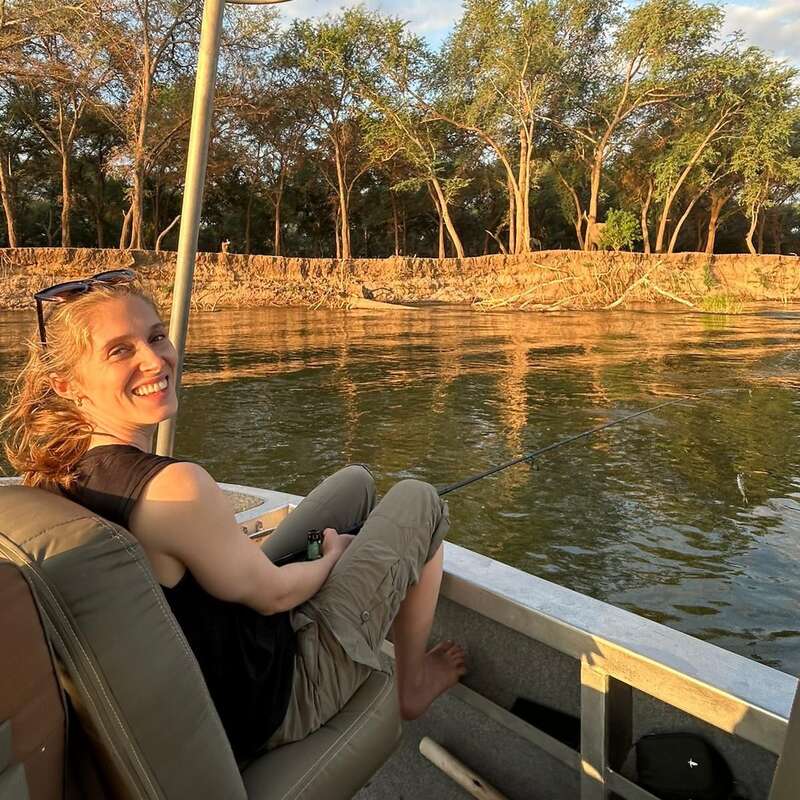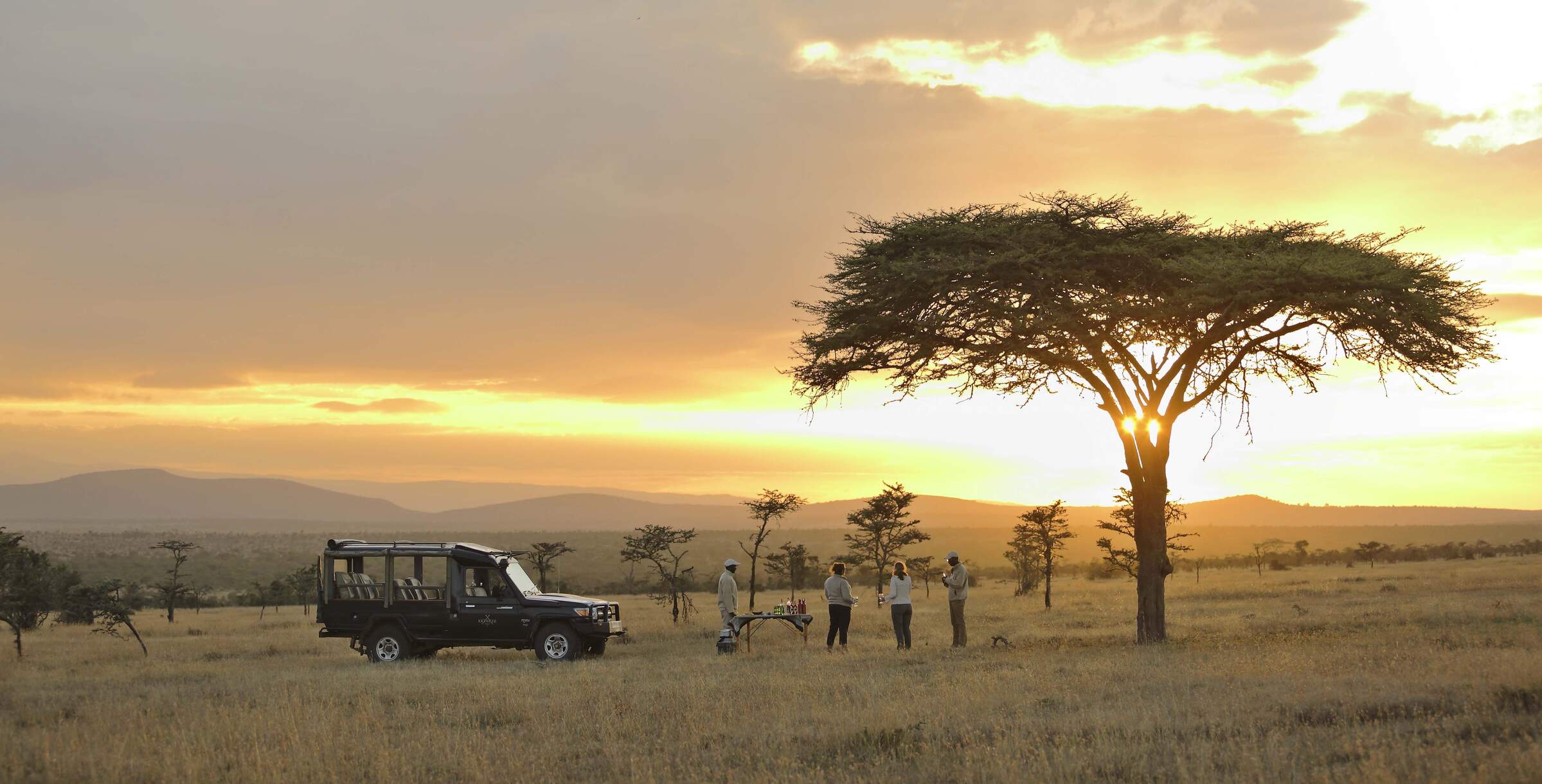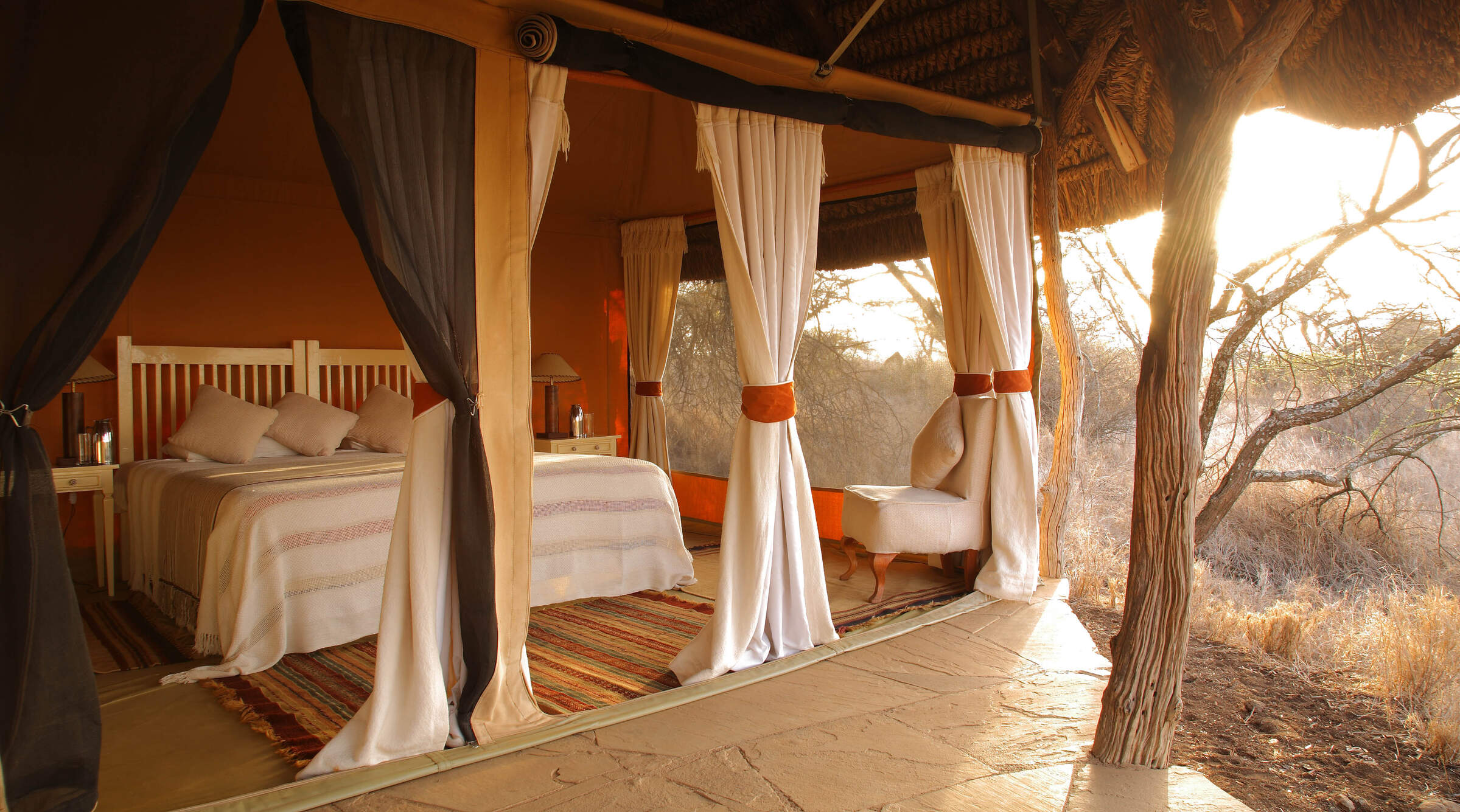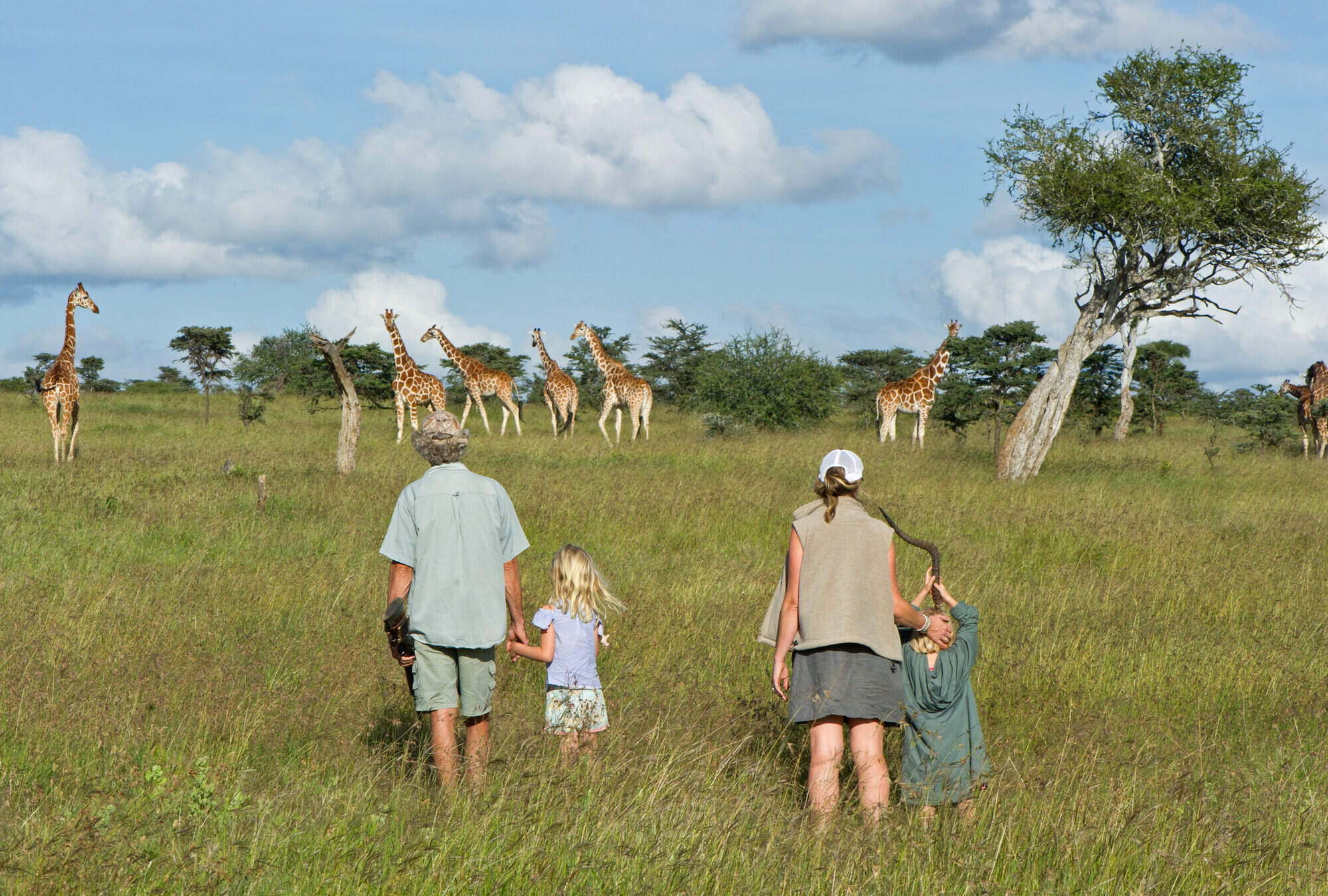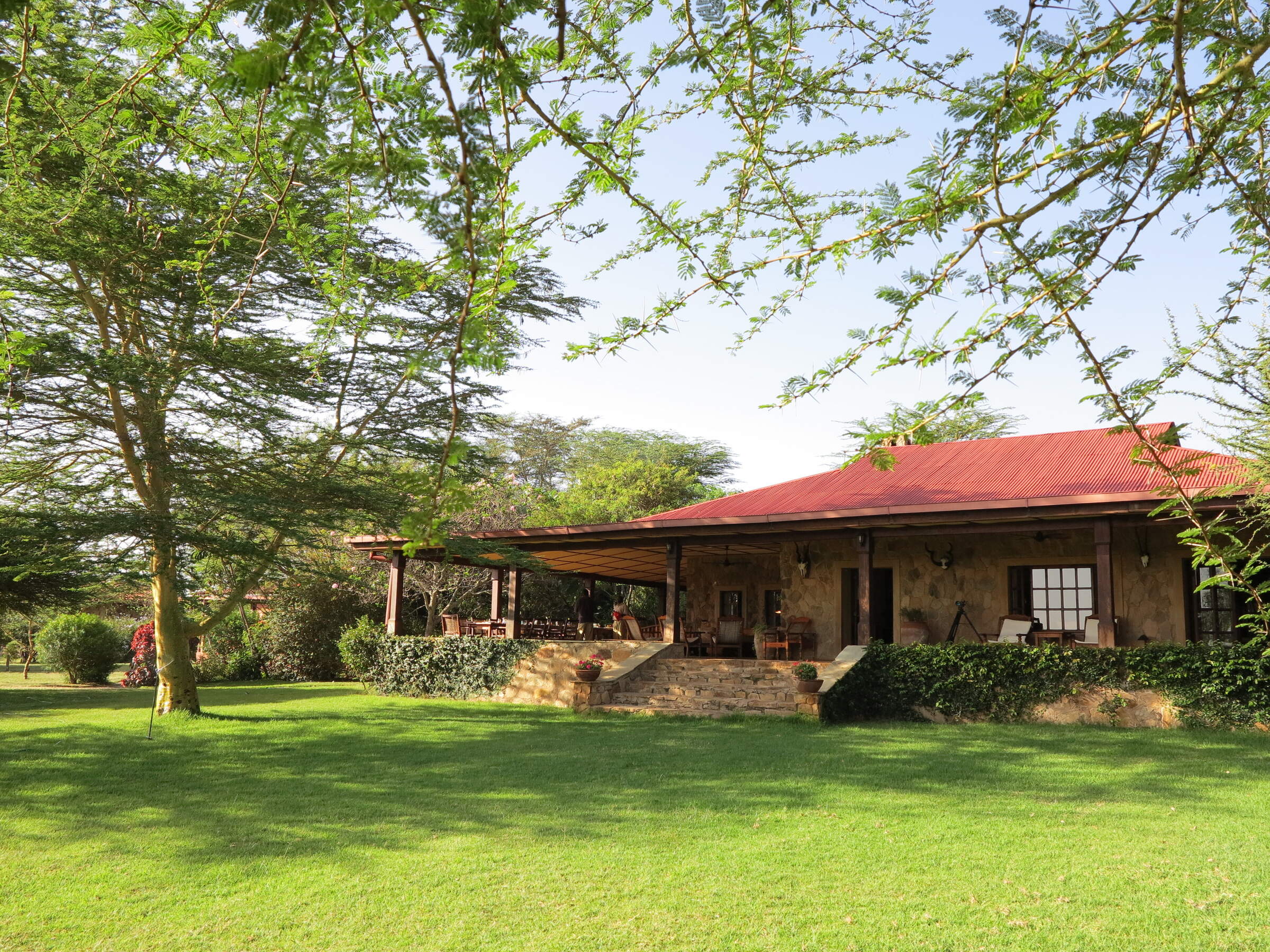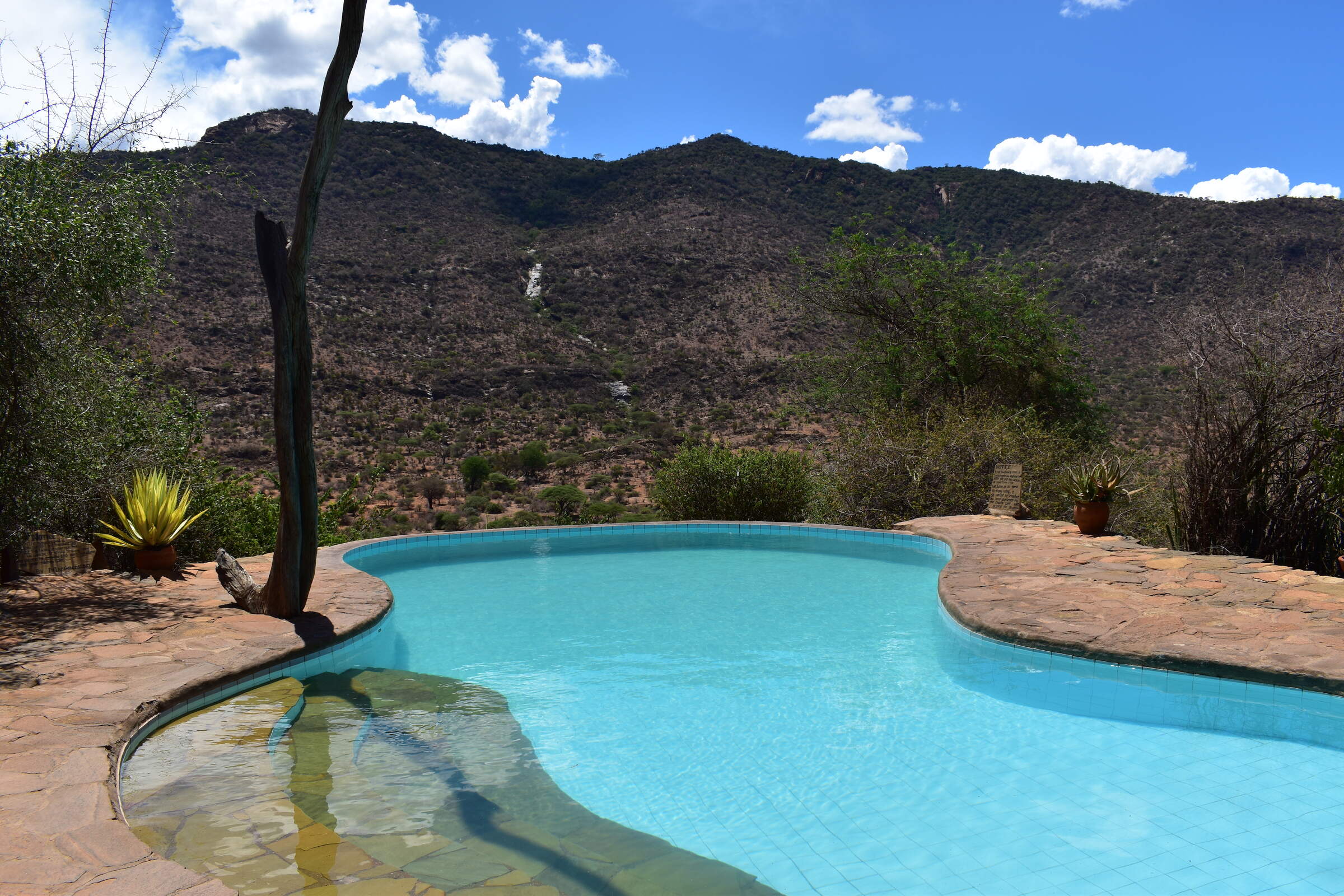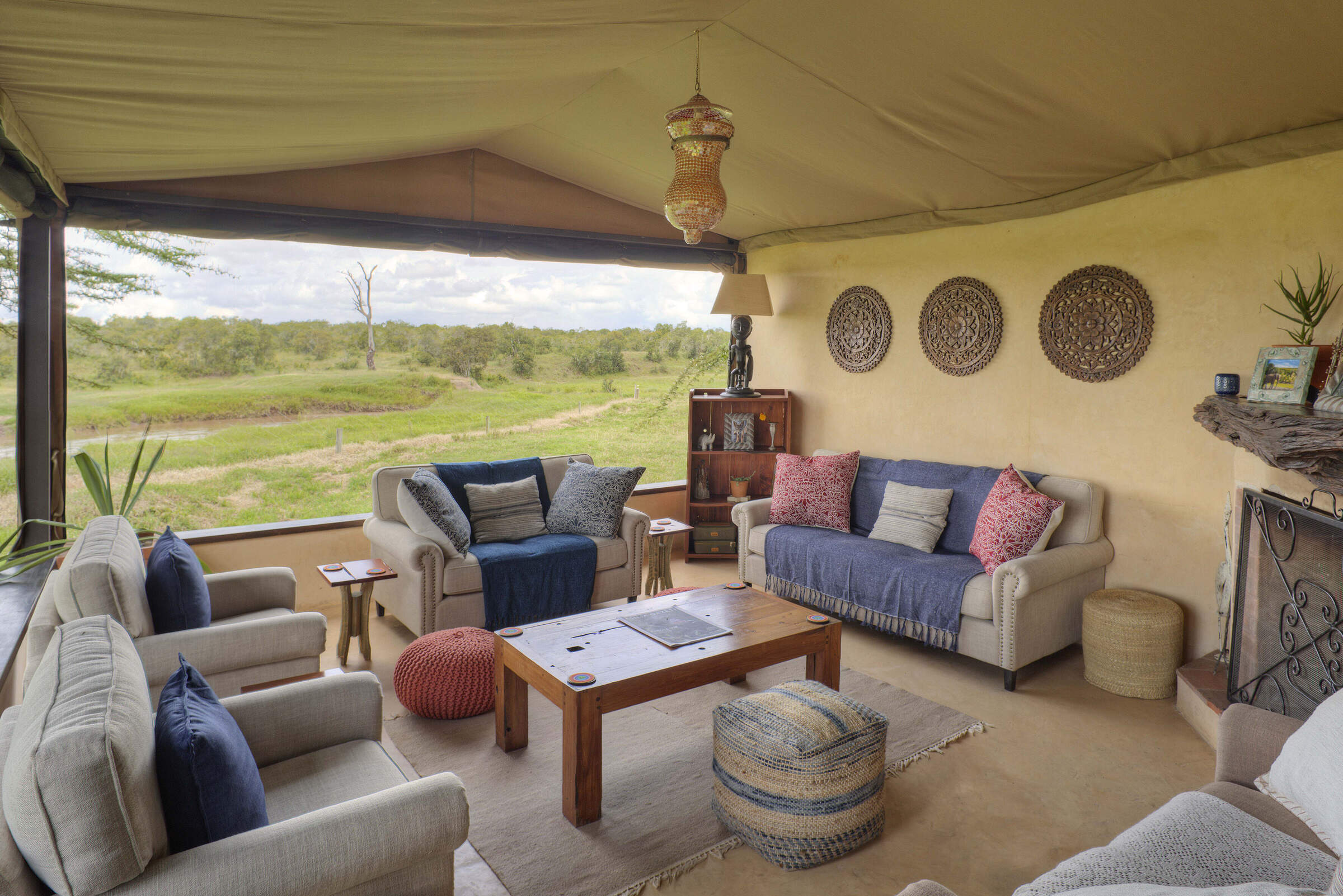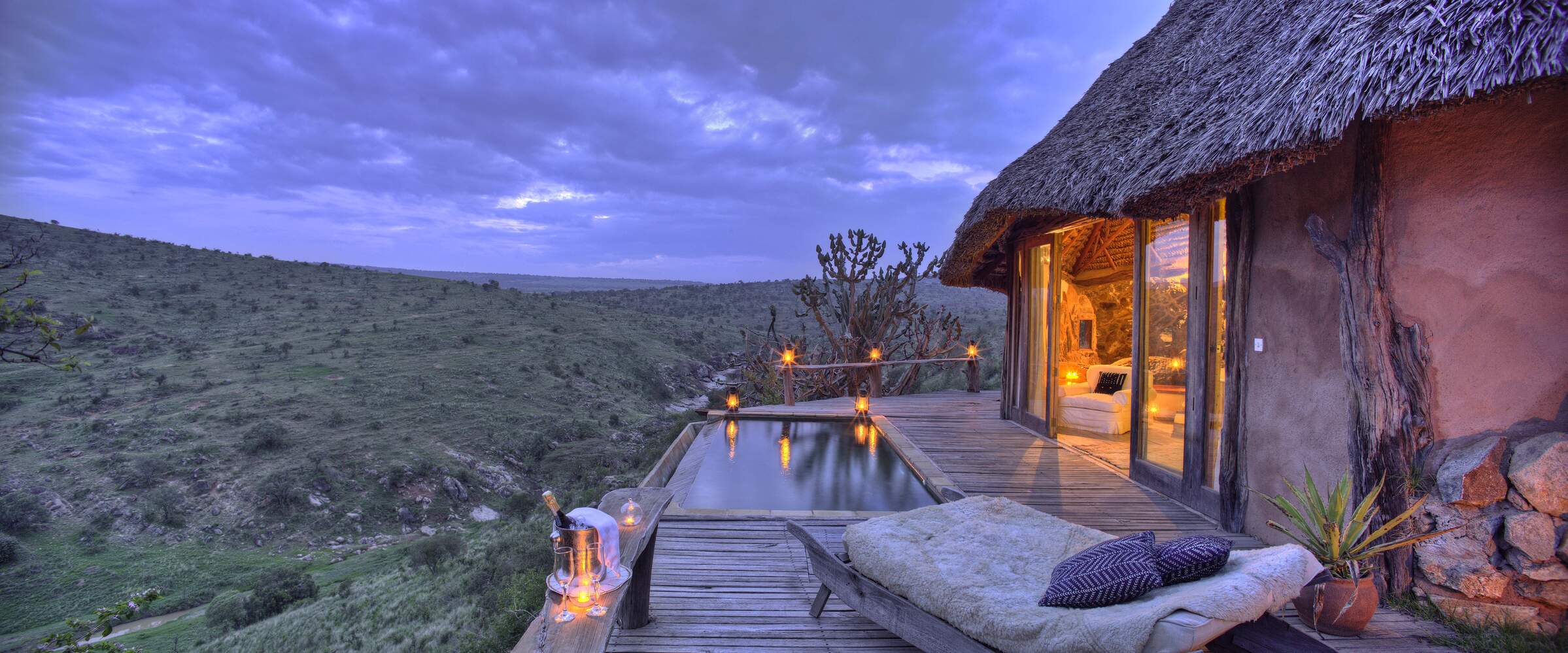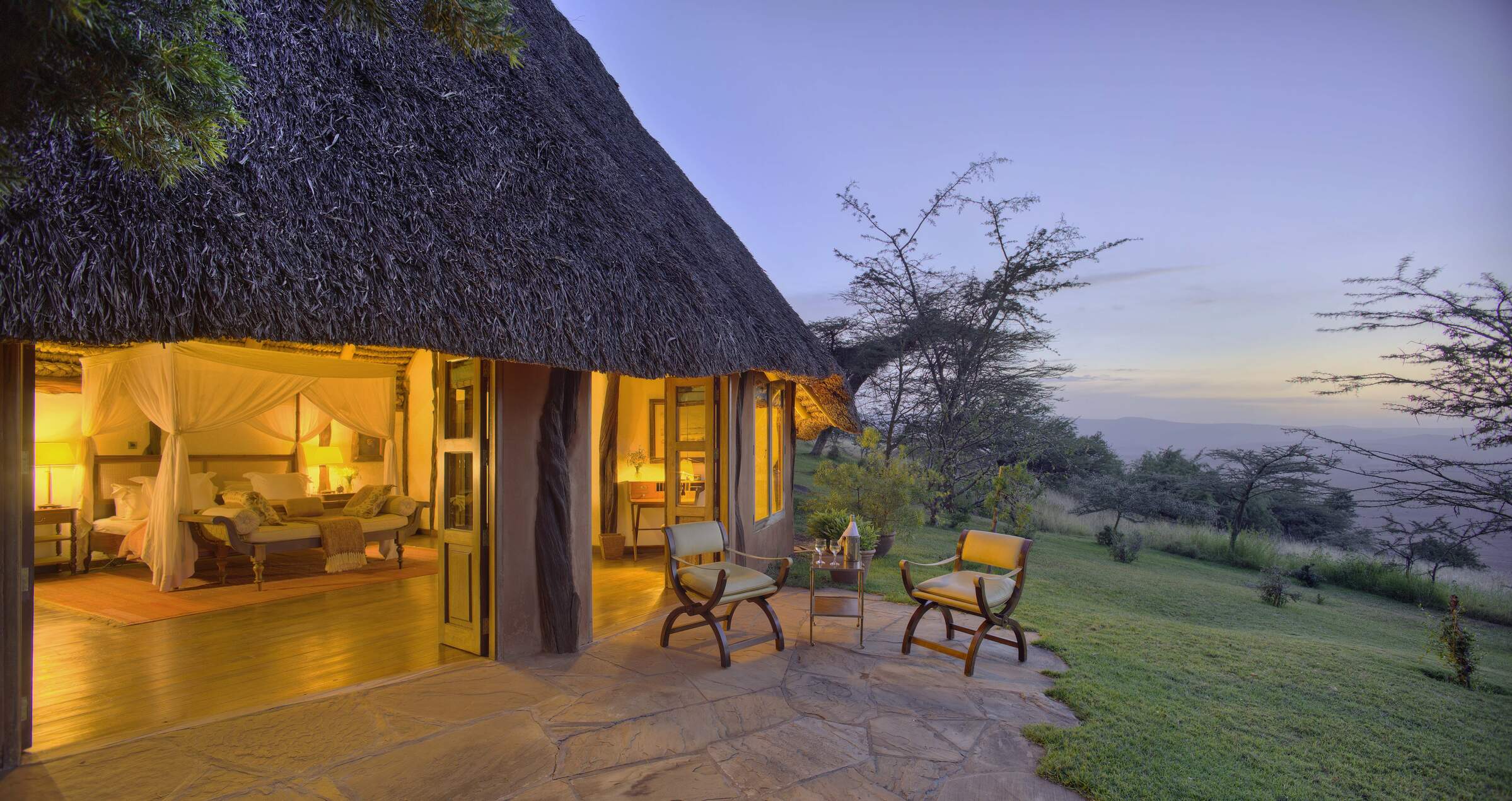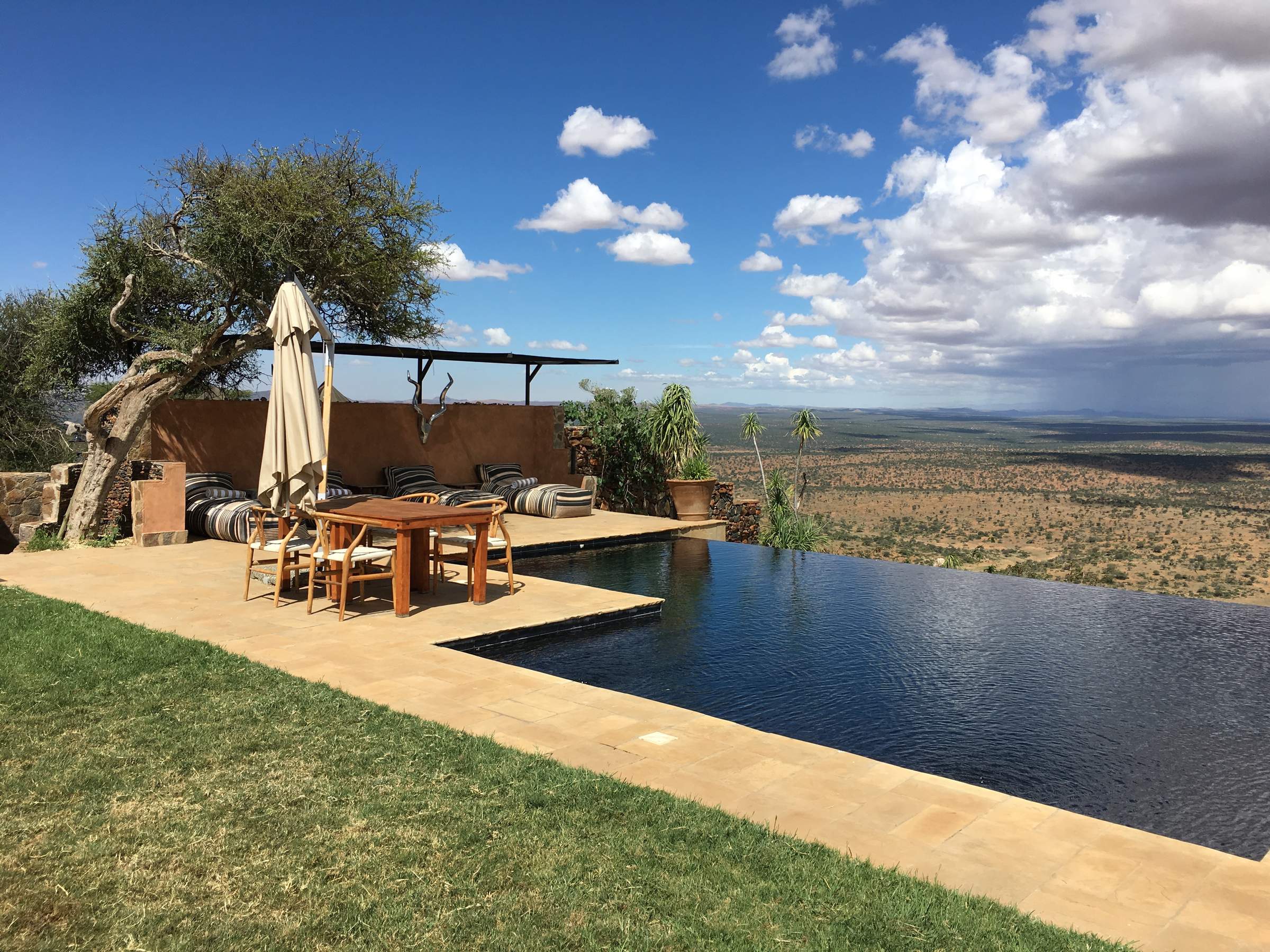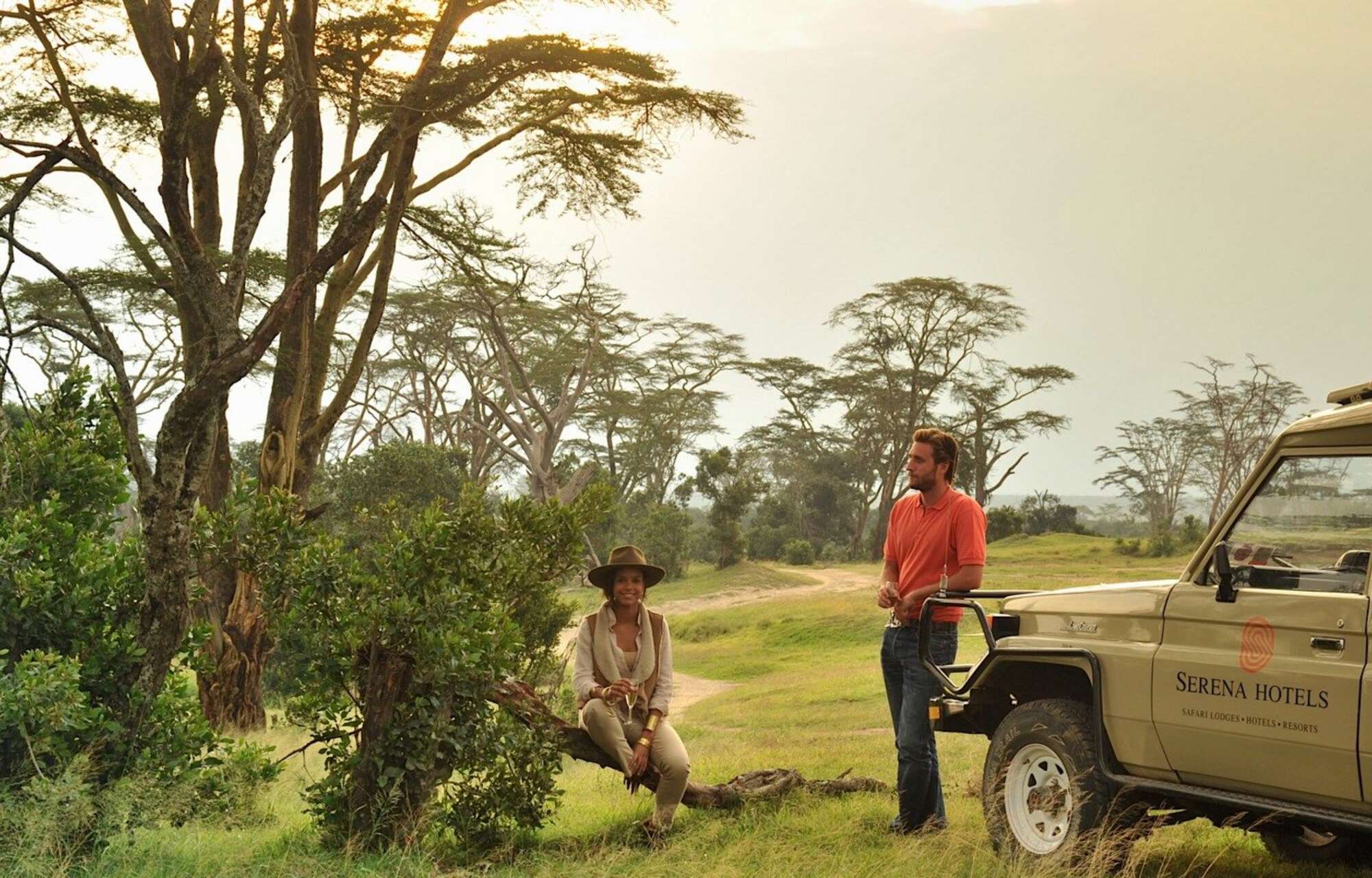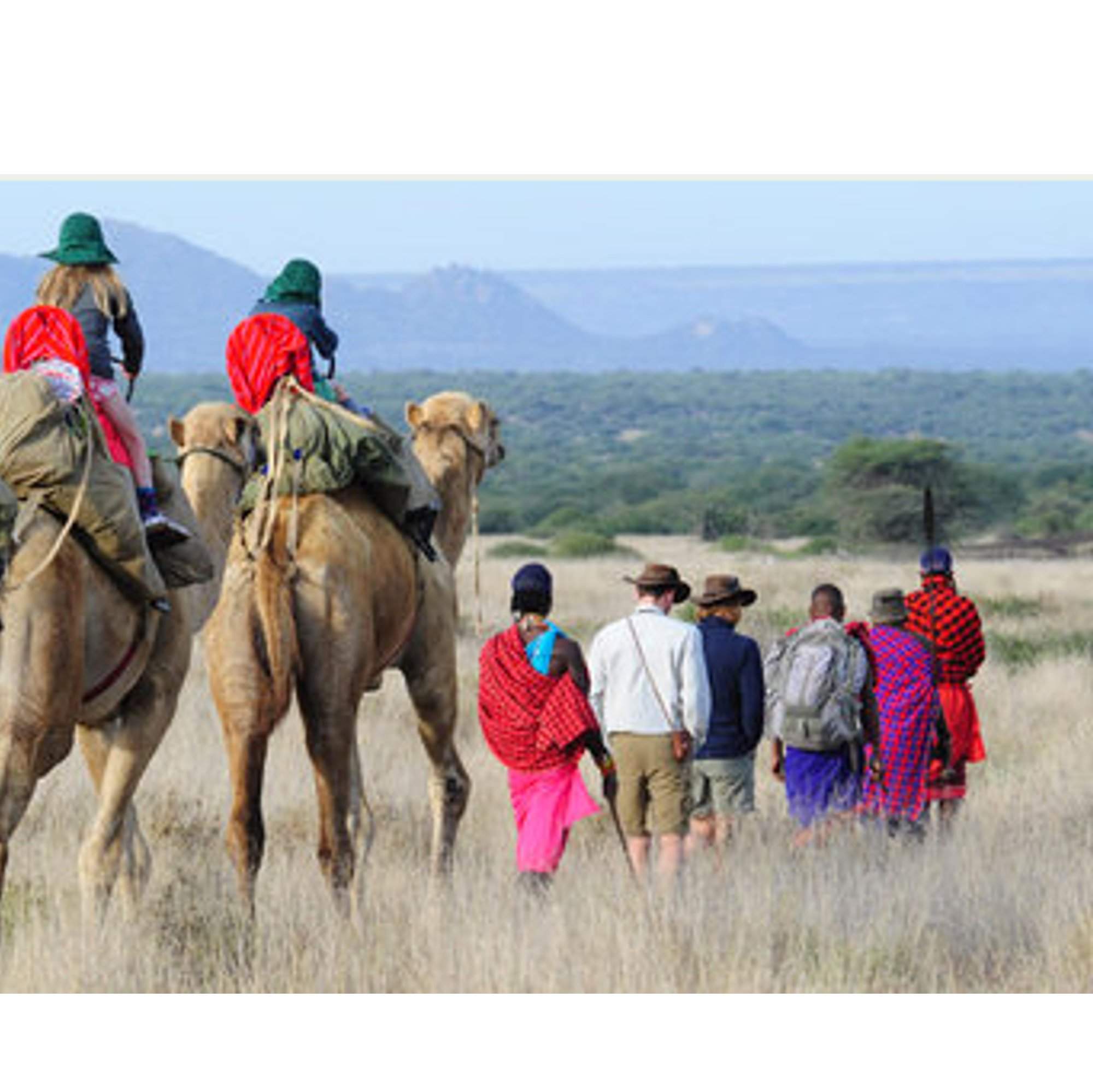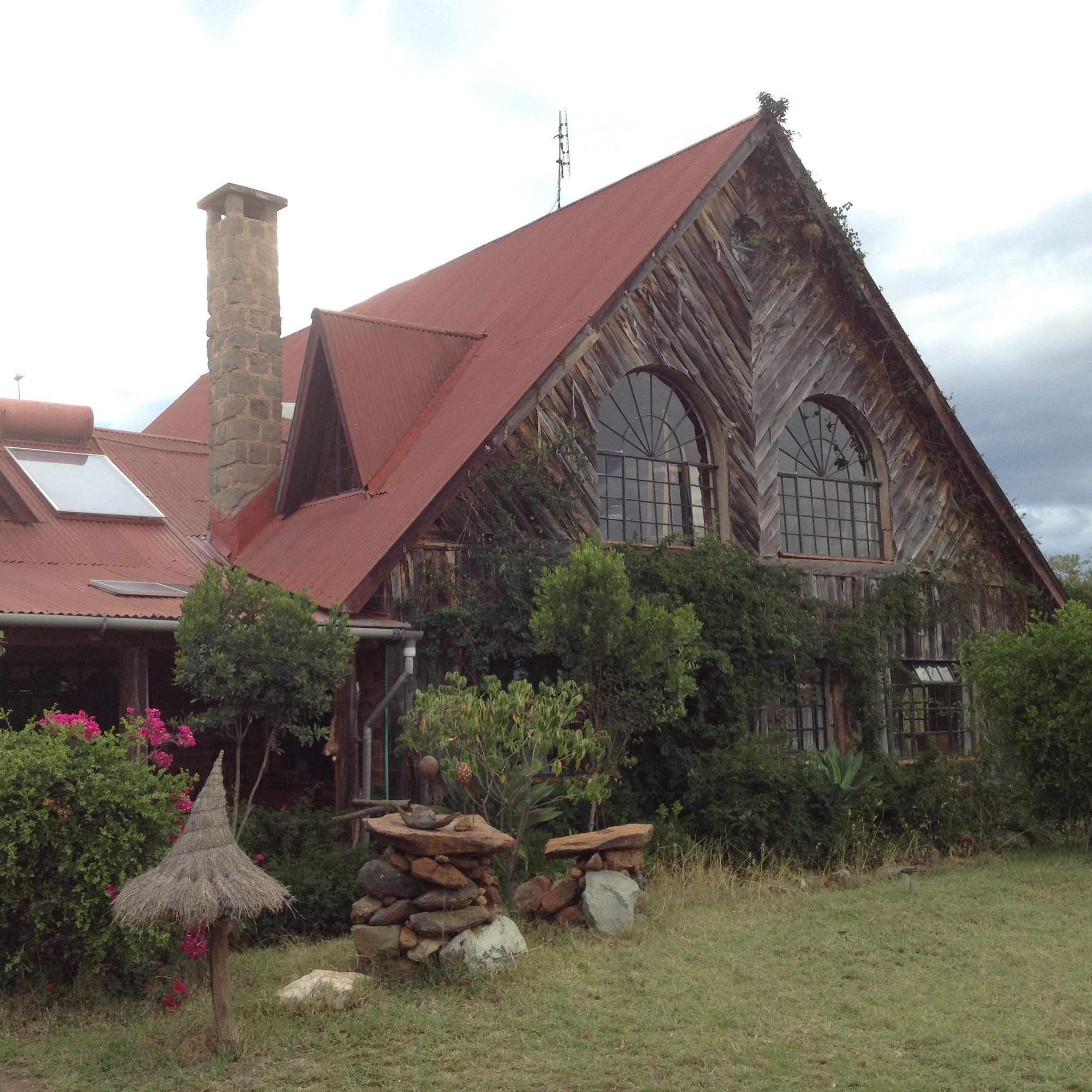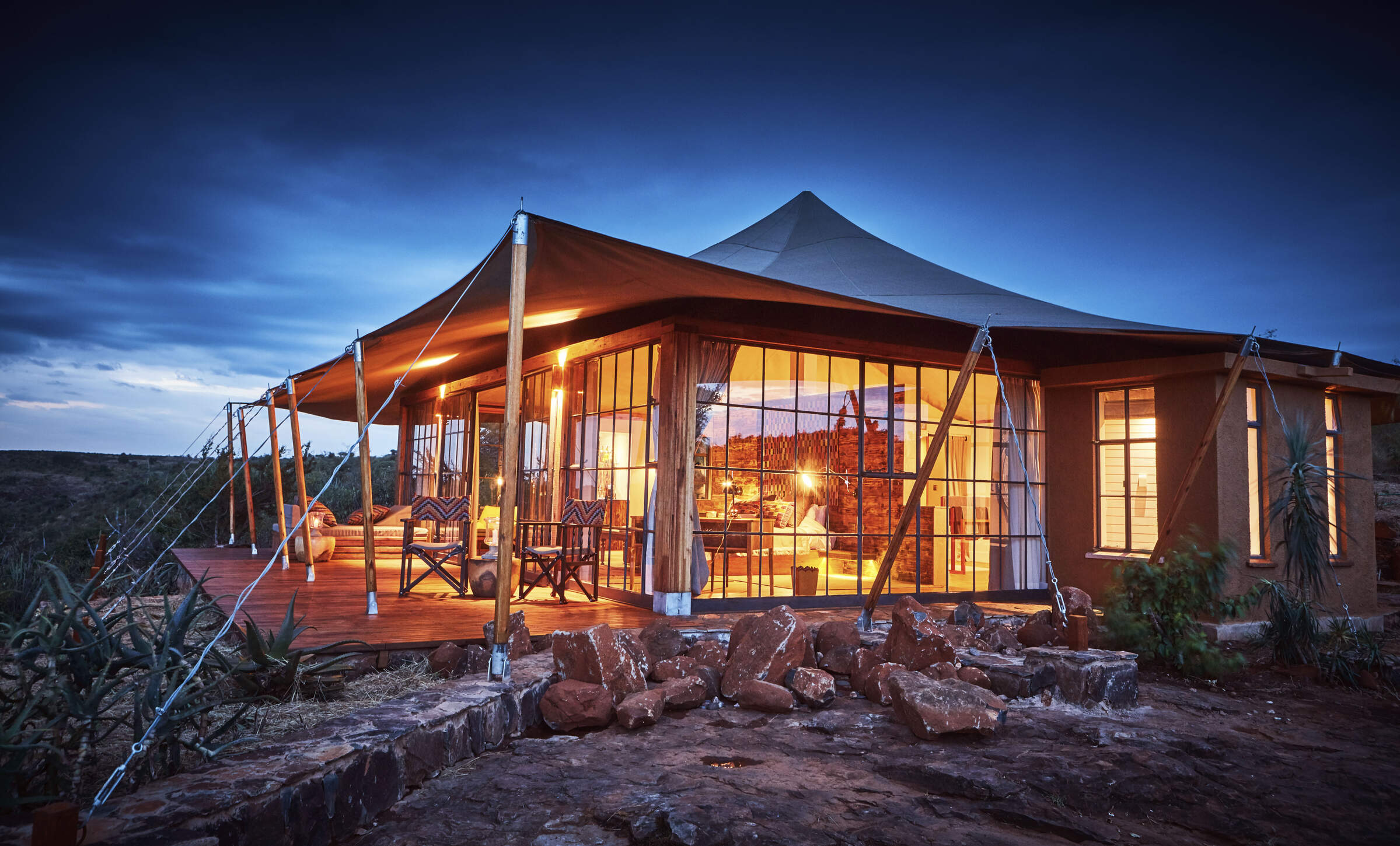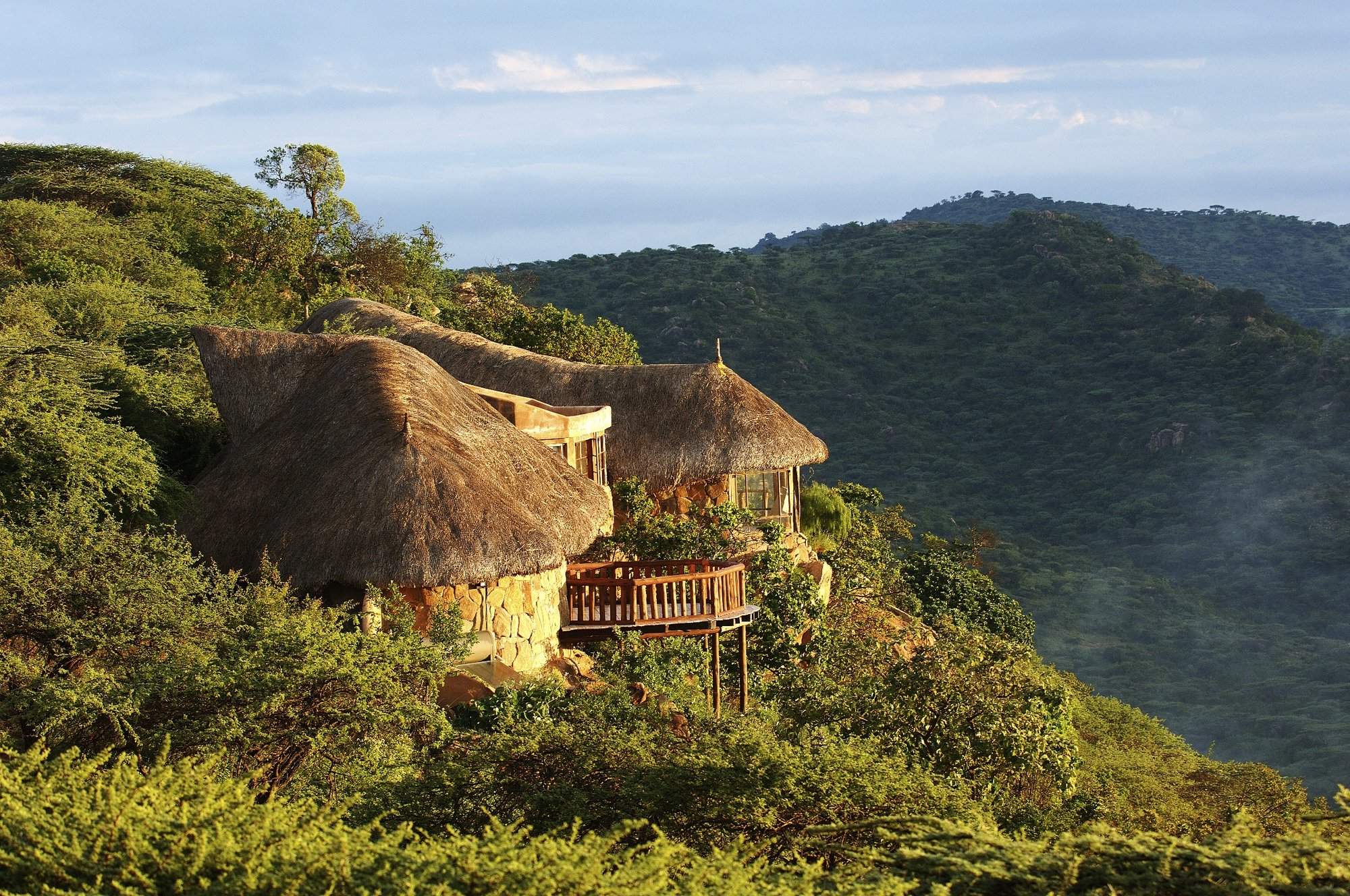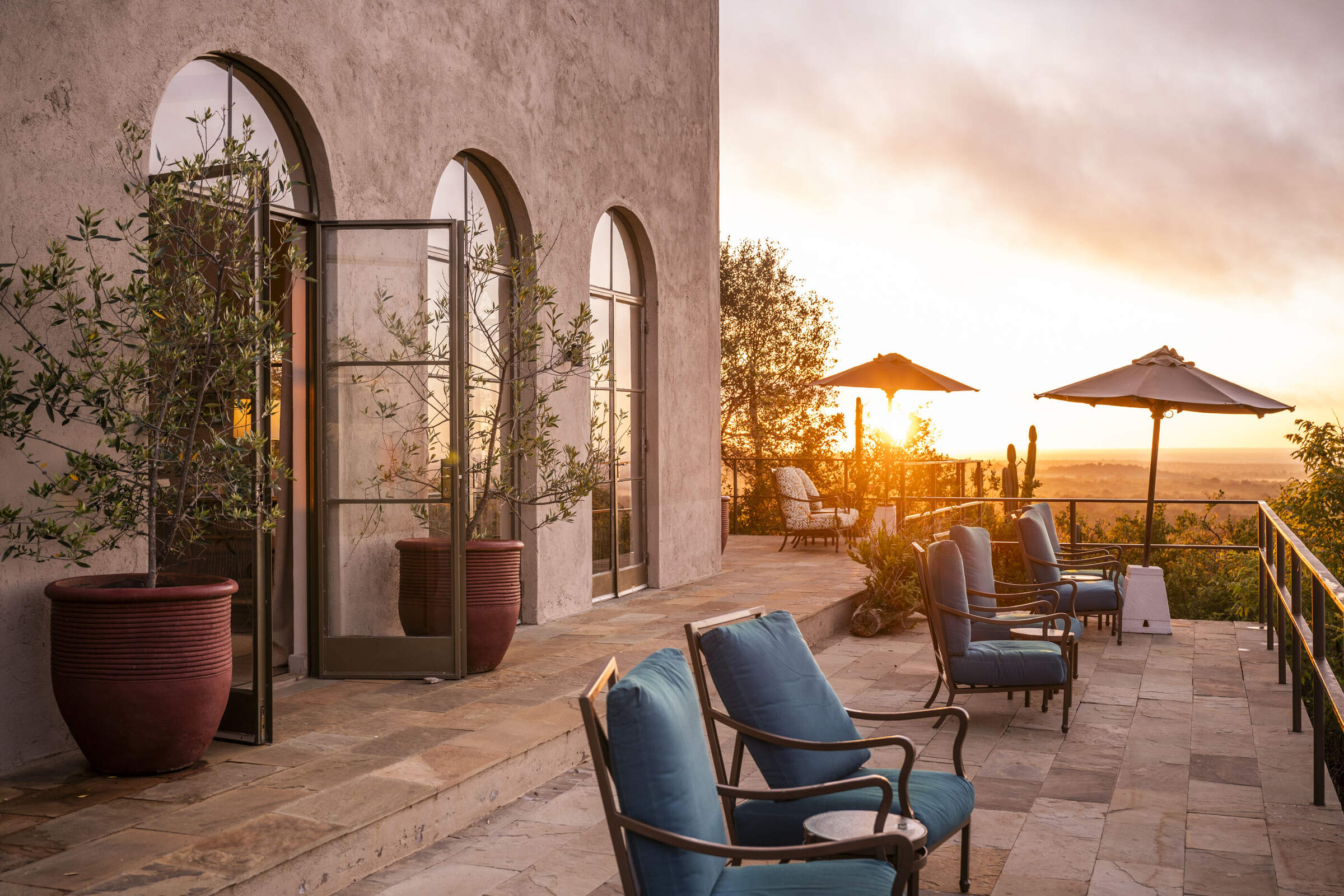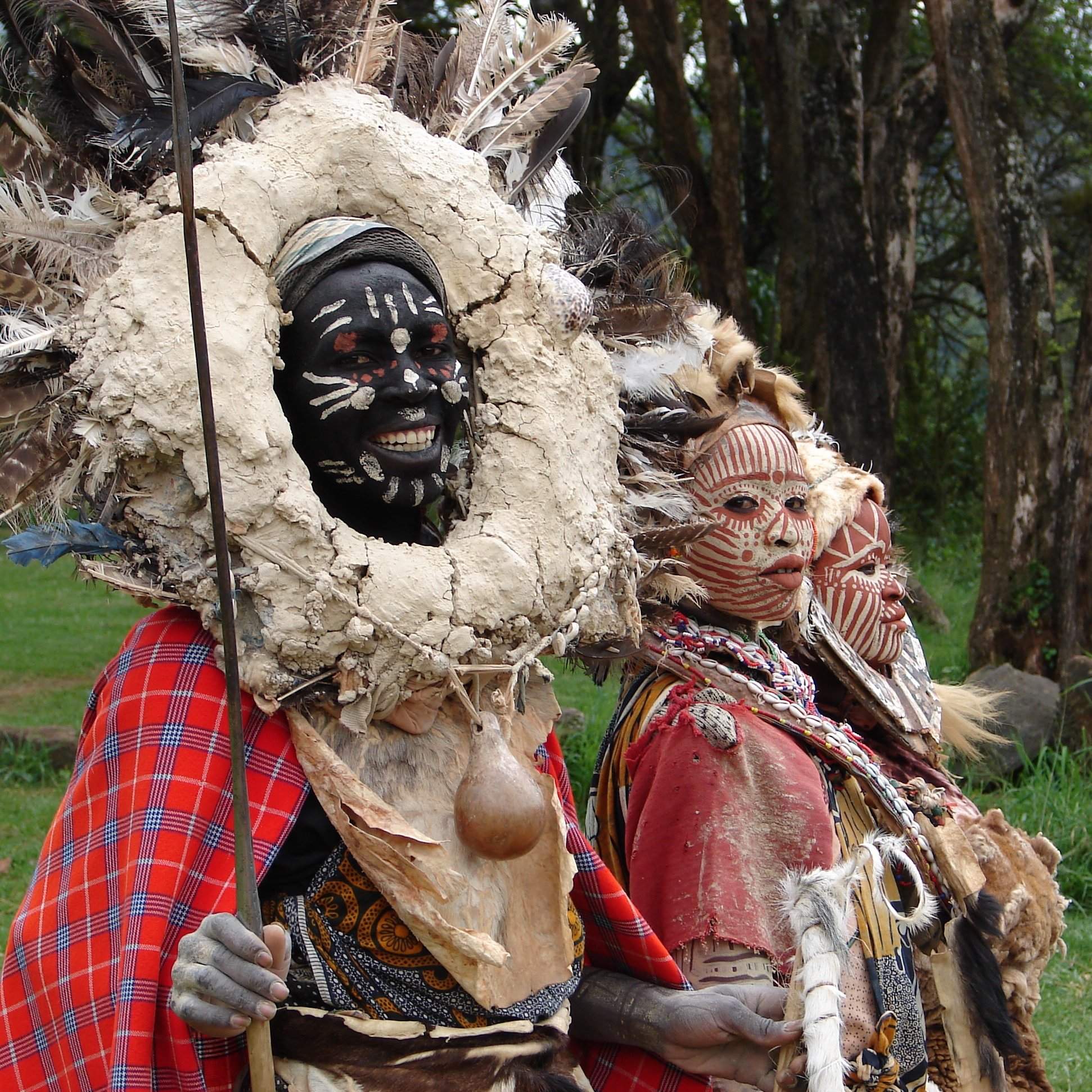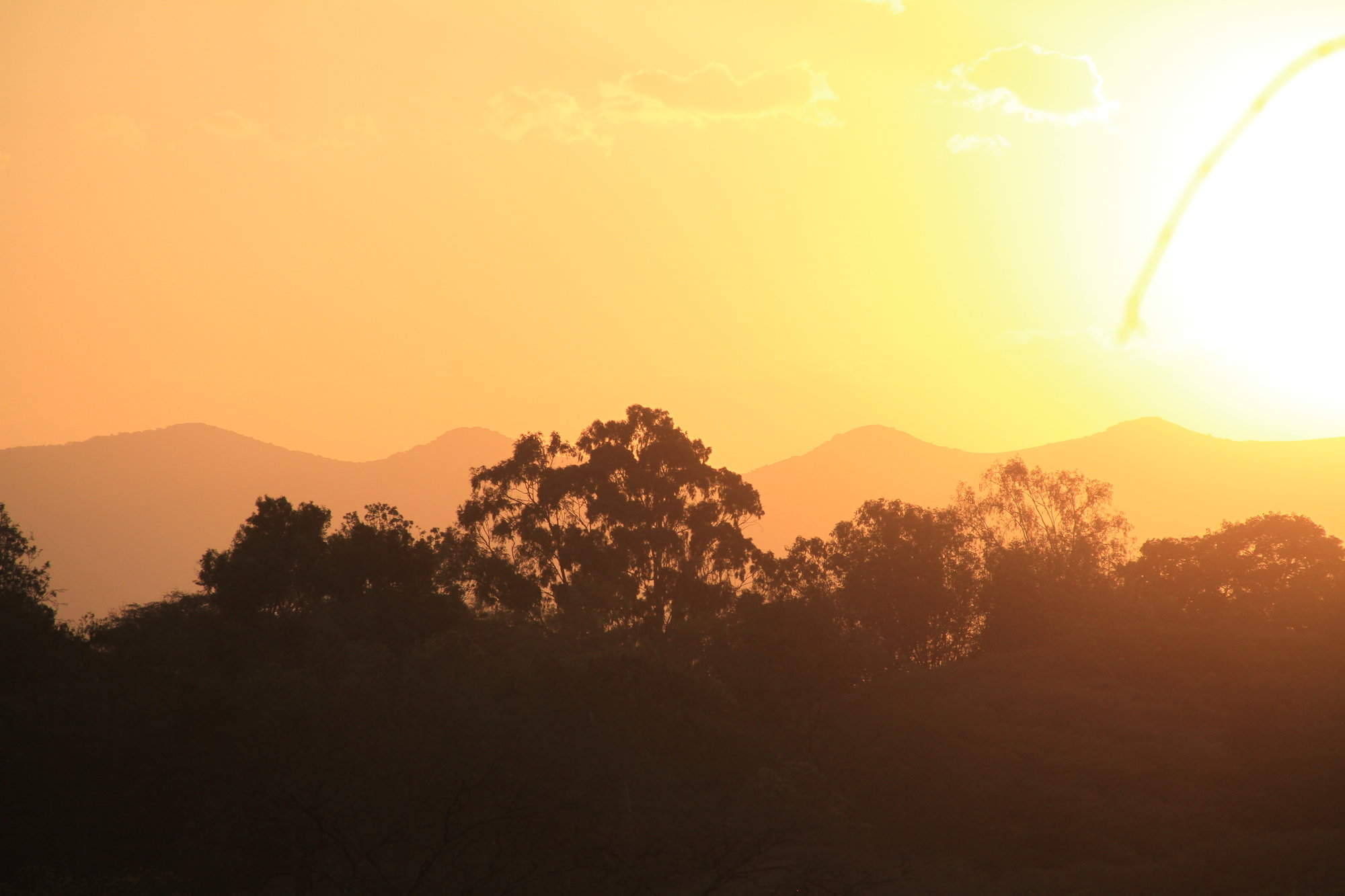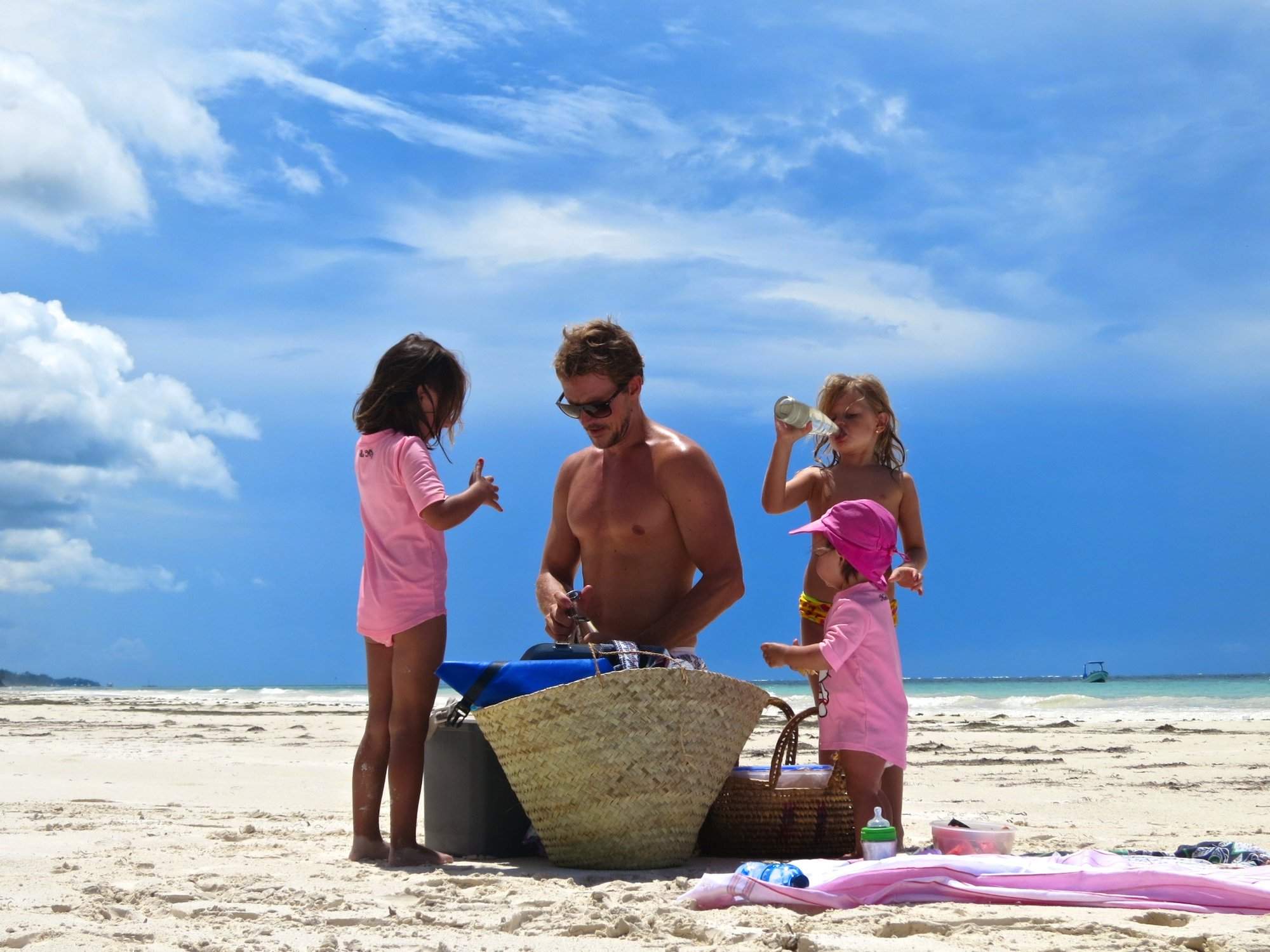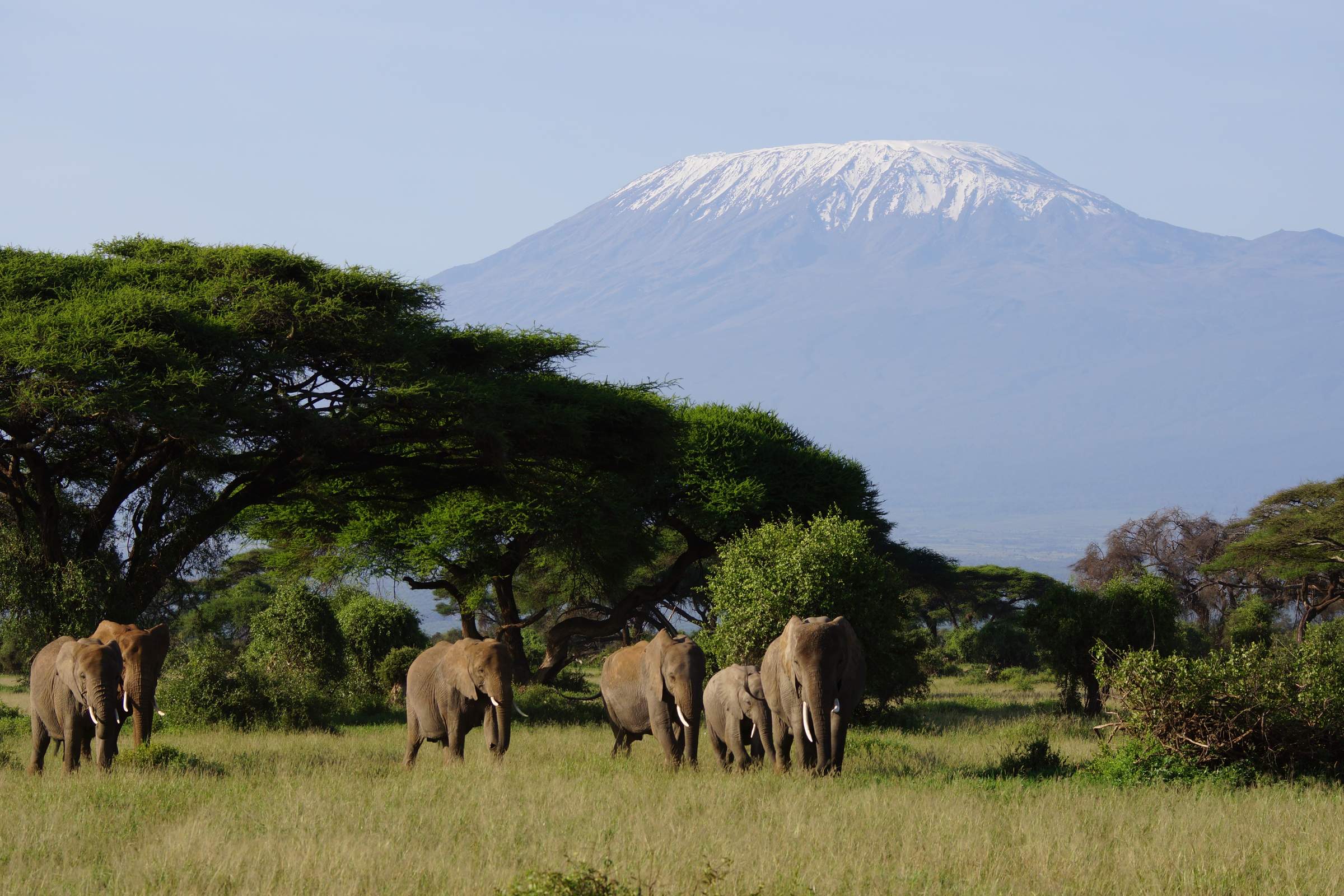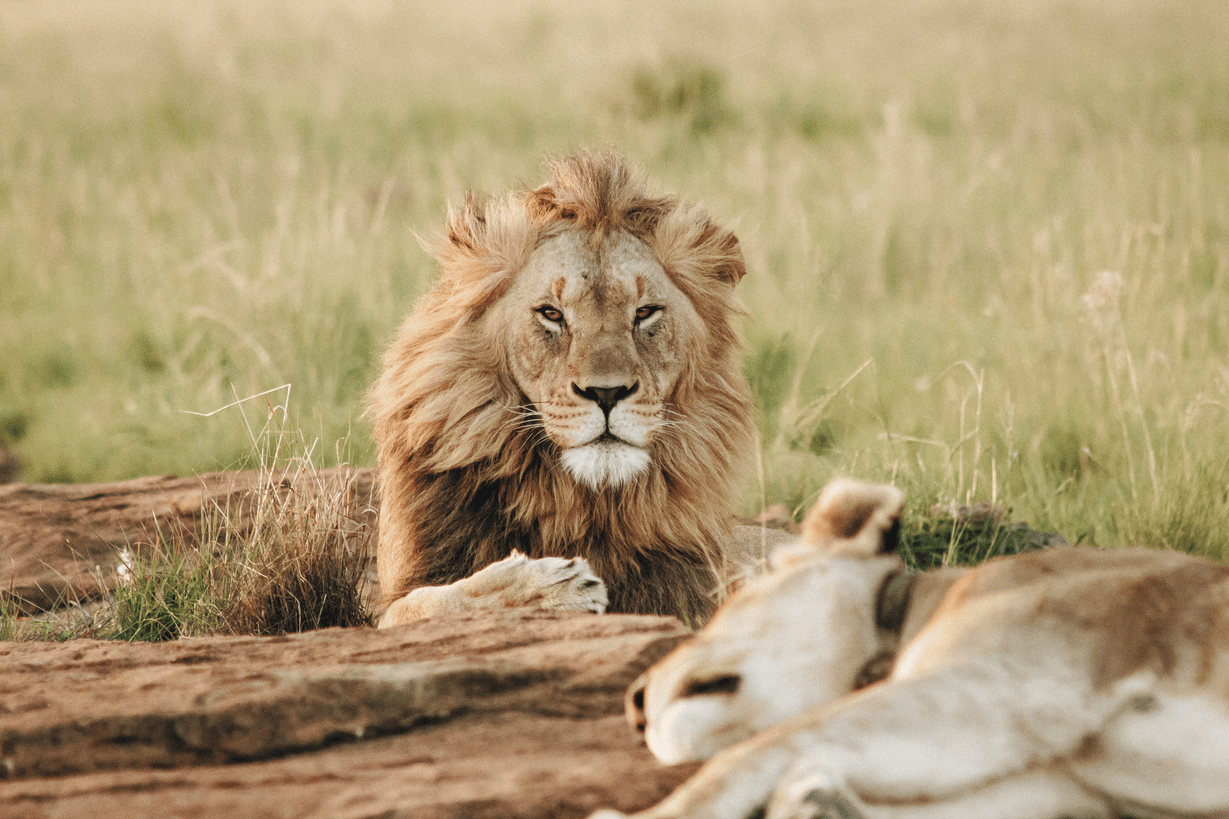Laikipia Wilderness: Our full report
Laikipia Wilderness opened in 2012 on the Ol Doinyo Lemboro Ranch about 2 hours drive north of Nanyuki.
The camp has now split into three divisions: Main Camp, River Camp, and Palm Camp - all spaciously spread to offer an intimate safari experience supported by a small team of excellent staff. It specialises in game walks as much as game drives, with fly-fishing, mountain biking, and river rafting and swimming also available.Main camp's central areas consist of a large lounge/dining tent (the “mess") with cane furniture and a small library of reading material, leading out to a raised deck area where breakfast, lunch, and afternoon tea normally takes place. Dining is typically communal unless there are distinct groups, with the guides and camp managers joining guests.
The six guest tents in the Main Camp are a good size, simply furnished with comfortable beds, bedside tables and lamps, storage shelves, and verandas with cane chairs and day beds looking out across the bush. Four of them are designed for families, with twin beds in a clever additional wing (which can be zipped off so the tents can also be used as a conventional double). We love the large, open bathrooms that are accessed via a zip-up canvas wall at night (and left open during the day), with plumbed-in, super-hot, high-pressure showers heated by kuni boilers (wood fire boilers) that are located behind each tent.
Behind the very simple kitchen and back-of-house area, a nearby rocky bluff looks north across the Ewaso Narok river (which flows north to join the Ewaso Nyiro a few miles downstream), and on this beautiful vantage point you'll often have sundowners or dinners around the fire.
There's a deliberately basic infrastructure at Laikipia Wilderness that keeps it all very real, and very “bush". There's been virtually no landscaping of the camp area, so the narrow footpaths between the mess and the guest tents lead through natural scrub. It's a largely natural environment, welcoming to the local wildlife. You will certainly see dik-diks in camp and may well have cause to be grateful for the night-time askari who ensures that the local buffalos and leopards don't become too comfortable here.
If you're staying for more than a couple of nights (as nearly every guest does), fly-camping is usually offered, a few miles from camp, with small tents and bedrolls. This often takes place either around the campfire or on one of the camp's elevated sleepout decks (equipped with a discreet drop-loo), overlooking watering holes and dams that are usually frequented by hippos and elephants. You will always be accompanied by a trained firearms holder with a .375 rifle.
Animal “hosts" at camp include three friendly dogs. The dogs sometimes accompany game drives and walks and seem to have a calming effect on wild dog packs. They can be rumbustious and very playful, so guests need to have a positive attitude to man's best friend. The whole camp has a very relaxed feel, as if you were staying with friends at their makeshift rural homestead.
Close to the river, Laikipia Wilderness has an annexe in the shape of "River Camp", consisting of a mess area and kitchen, with five simple, ensuite guest cottages. River Camp is usually booked by large groups on an exclusive-use basis, but can also be used as an overflow camp on occasions.
The third branch of Laikipia Wilderness is the newer "Palm Camp", also consisting of a large open-plan mess area with bar, comfortable chairs, and dining area. The five rooms here are elevated on stilts, offering a front-row view over the river that runs right in front of camp. As with River Camp, Palm Camp is booked on an exclusive-use basis with a minimum occupancy of four guests, and works especially well for adventurous families or groups looking for a more private experience away from other camp guests.
In some camps, the comforts and atmosphere of the camp itself vie for attention with the out-of-camp activities on offer. That's not the case at Laikipia Wilderness. While the tents, lounge, mess and deck are perfectly comfortable (and the kitchen's output delicious), the most memorable aspects of a stay here are the day and night game drives (they have several Land Cruisers in various formats, including three photography vehicles and first priority black leopard vehicles – you can request a fully open one for game drives), morning and afternoon game walks, and really great guiding.
The typical driving style of the guides means you can make rapid progress through the bush, with game drives often taking place along the ranch's riverbanks where leopard sightings are comparatively frequent – the typically ultra-cautious driver/guide's manner behind the wheel might be a bit slow in the fast-moving world of wild dog packs and melanisitic leopard cubs. With no other camps or visitors across miles of rocky bush, you can go wherever your guide thinks he or she can drive – and then, when the vehicle can go no further, you get out and walk on, briefed in advance to follow the safety rules. This makes for an unusually robust approach to game viewing: you need to be prepared with suitable footwear for getting out of the vehicle at a moment's notice when your guide or spotter sees something interesting (and possibly getting back in again just as quickly). It's an approach to safaris that is a far cry from the slow and gentle style that is particularly common in small camps in the Mara. When tracking the dogs and cats, you need to be prepared to acquire the odd bruise and knock along the way.
The rewards of this rather rough and ready style include good opportunities to see the area's wild dogs. While the population was seriously reduced in 2017 following an outbreak of canine distemper which wiped out one of the two packs in this area, the other pack stabilised and numbers are increasing, and over the course of 2019-2021 two packs once again began denning in the district.
The pack that sometimes dens at Ol Doinyo Lemboro Ranch can range far and wide over hundreds of square kilometres, but it includes collared individuals and the camp usually has radio telemetry tracking equipment, so there's a reasonable likelihood of encounters, if sometimes fleeting ones. During the denning season, which varies each year on a roughly 9-10 month cycle, the den areas are deliberately not approached too closely. Once the pups leave the den, however, approaching the pups becomes easier. Throughout the year, the packs hunt daily and are fluidly mobile, so you can come across the adults almost anywhere and you're almost certain to have the whole experience to yourself.
When the dogs are denning in the neighbouring ranches of Mpala and/or Chololo, they sometimes operate a half-day-visit system (each ranch charges ~US$60 per person) that allows keen travellers to widen their wildlife searches while staying at Laikipia Wilderness. This can be particularly useful during the dogs' denning season, but it does need to be arranged in advance and cannot be guaranteed.
Ol Doinyo Lemboro Ranch includes a sizable dam, where the camp has built a simple raised pavillion, that is ideal for breakfasts, brunches, sundowners and sleepouts. Sitting here to watch nearly 100 elephants drink, bathe and play was an absolute delight.
During our last visit, the wild dogs were hunting in a remote area so we didn't see them, but the female black leopard whose territory falls around Laikipia Wilderness' camps was very much in evidence. In fact, we saw not only her but also three other leopards in the same afternoon game drive that included wonderful and sometimes surprising interactions between the individuals. Melanism in leopards is a recessive gene which generally doesn't favour the animal's life chances (a black leopard stands out by day and even at night under moonlight, while spotted leopards are notoriously hard to see until they move), but there is now a population of at least six black leopards in this part of Kenya, with territories on Ol Doinyo Lemboro and neighbouring Loisaba Conservancy.
Using a discreetly deployed spotlight, our vehicle drove through the bush in the dark to follow both the black leopard as she stalked dik-dik and her territorial rival (a large, spotted male leopard which relies on her hunting skills to steal some of his meals). The excitement of these encounters is intense, though photography is challenging and the camp is keen to keep expectations at a sensible level to allow the cats to behave naturally. The general wildlife we saw included large numbers of elephants (including while we were on foot, at close quarters, from across a dry stream bed), greater kudu, both plains and Grevy's zebras, and numerous giraffe. There are dik-diks everywhere – the wild dogs' and leopards' favourite prey – and the area certainly feels richly endowed with wildlife.
Keen birders will be delighted with the area, which has hundreds of northern species as well as those ranging across Kenya, and Palearctic migrants. Local specialities include rosy-patched bush-shrikes, vulturine guinea-fowls and impressive range of raptors, including black eagles, attracted by the area's rocky outcrops. Steve Carey knows all the birds, and their calls (and does a fair few passable imitations himself).
Our view
Knowing the highly experienced Zimbabwean owner of this camp already, we guessed it would be a great experience, and we were right. Our last stay confirmed its appeal as coming down very much to the camp guides' uncanny and very hands-on bush instincts. The wild dogs have made a great comeback and the camp's star black leopards are a magical draw. If you want to feel the Laikipia wind in your hair as you bounce along a rutted track searching for wildlife, this is the place for you.
Geographics
- Location
- Laikipia, Kenya
- Ideal length of stay
- We suggest four nights to experience all that this area has to offer.
- Directions
- It is a 1.5-to-2-hour drive from Nanyuki airport, accessed by light aircraft from Nairobi Wilson Airport. Alternatively, fly to Loisaba airstrip, on the conservancy of the same name, and do a 1.5 hour transfer (or a 2-hour game drive) to reach camp.
- Accessible by
- Fly-and-Transfer
Food & drink
- Usual board basis
- Full Board & Activities
- Food quality
- We have always thought the quality of meals at Laikipa Wilderness is very good, and particularly so considering the very basic infrastructure at the camp, and again on our most recent visit we were not disappointed.
The day starts with a hot drink in your room, or at the mess along a snack breakfast before the morning activity, with a bigger breakfast on return, or out in the bush. A good range of fruit, cereals, eggs, bacon, sausage, and beans is always available, together with homemade bread and toast and preserves.
Lunch or brunch (often eaten on the big deck by the dam while watching elephants splashing in the water), is usually a wonderful buffet selection of colourful salads and freshly baked bread, along with quiche, pizza or a similar light food.
Dinner is either served out in the bush or back at camp. On one stay we had a barbecue on the sandy banks of the river. When we got there the team had already set up dinner with a blazing log fire and a table laden with drinks and food. On the fire they cooked a large fillet steak, which was served with potatoes filled with cheese and mixed vegetables roasted on the fire. This was followed with a very tasty pineapple crumble. - Dining style
- Group Meals
- Dining locations
- Indoor and Outdoor Dining
- Further dining info, including room service
- Meals can be had anywhere you want, including at your tent. Guests can also request a private rock dinner (on the rocky viewpoint), or bush dinner (in the bush somewhere).
- Drinks included
- All available drinks are included in the rates, which means the usual soft drinks, beer and house wines. Guests wanting particular spirits or Champagne could order ahead (at extra cost) or bring their own.
Special interests
- Family holidays
- This camp has an adventurous, outdoors feel. The owners’ children have grown up with the camp and this shows in their family-friendly approach and the immersive bush experiences offered. Several spacious family tents accommodate 4 to 6 people.
- See ideas for Family holidays in Kenya
- Solo Travel
- Laikipia Wilderness is one of the few camps in Laikipia not to charge a single person supplement all year round and its focus on wildlife and immersion in the bush makes it a great choice for a safari enthusiast travelling on their own.
- See ideas for Solo Travel in Kenya
- Birdwatching
- Keen birders will be delighted with the area, which has hundreds of northern species as well as those ranging across Kenya, and Palearctic migrants. Local specialities include rosy-patched bush-shrikes, vulturine guinea-fowls and impressive range of raptors, including black eagles, attracted by the area's rocky outcrops.
- See ideas for Birdwatching in Kenya
- Photography holidays
- Laikipia Wilderness has been a consistent draw for keen wildlife photographers since it opened, with sightings of wild dogs frequent, and periodically reliable. Similarly, the appearance of black leopards near the camp has provided excitement and challenge for photographers.
- See ideas for Photography holidays in Kenya
- Walking safaris
- This camp specialises in game walks, encouraging exploration of Laikipia’s bush. The guiding is energetic and enthusiastic, and guests regularly find themselves leaving their vehicle to follow sightings far from the beaten track.
- See ideas for Walking safaris in Kenya
- Wildlife safaris
- Laikipia Wilderness and Steve Carey are known for wild dog tracking. Two packs den nearby, with frequent cub and hunt sightings. The area's dense dik-dik population supports wild dogs and high leopard numbers, and the camp's black leopards have become a famous attraction.
- See ideas for Wildlife safaris in Kenya
- Walking
- Owned and run by a true bushman with exhilaratingly hands-on instincts, Laikipia Wilderness specialises in phenomenal guided walks. Game drives also often feature walking stops, when you follow tracks on foot where the vehicle cannot reach.
- See ideas for Walking in Kenya
Children
- Attitude towards children
- Children are always welcome. However, this is a very relaxed, unfenced camp and children’s safety is definitely the responsibility of their parents.
- Property’s age restrictions
- None, but the camp may be selective, so it may not be possible to host a very young family in high season, especially if there are no other children at camp at the same time.
- Special activities & services
- Fishing, river rope swings, river rafting in the fairly shallow river (for older children, no life jackets provided), kayaking, cave-exploring, and rock-scrambling. Guide Joseph does tracking walks for fives and up, with bow and arrow skills-training.
- Equipment
- Apart from a baby cot and high chair, there is no specialist equipment for younger children.
- Generally recommended for children
- Keen outdoors- and animal-loving children will adore this camp and its robust style, but tiny ones will need careful supervision at all times.
- Notes
- Experienced, but not qualified, ayahs and child minders are available from housekeeping staff.
Our travellers’ wildlife sightings from Laikipia Wilderness
Since mid-2018, many of our travellers who stayed at Laikipia Wilderness have kindly recorded their wildlife sightings and shared them with us. The results are below. Click an animal to see more, and here to see more on our methodology.

100% success

100% success

100% success

100% success

93% success

76% success

68% success

63% success

58% success

48% success

46% success

9% success

0% success

0% success
Communications
- Power supply notes
- There is a backup generator but it is rarely needed. Charging your phone is possible within your tents, but charging for larger batteries and devices is done in the WiFi tent. No hair dryers can be used. Hot water is provided by wood-fired boilers behind each tent.
- Communications
- There is WiFi hut, just next to the main area and the strong Starlink connection also covers the communal mess tent. Safaricom cellphone network is also available, but only in the kitchen where there is an aerial.
- TV & radio
- There is a TV in Steve's house that you may be able to watch important sports fixtures on.
- Water supply
- Borehole
- Water supply notes
- River water is pumped up for the main guests’ bathroom supplies and good hot water is available more or less 24/7, heated by wood-fired kuni boilers at the back of each tent. Drinking water is brought in from Nanyuki’s mains supply and then treated in camp and supplied to guests in flasks. Bottled water is used on walks and drives.
Health & safety
- Malarial protection recommended
- Yes
- Medical care
- Some staff have had first aid training from Medex (a UK, ex-military training course).
- Dangerous animals
- High Risk
- Security measures
- There are two camp askari on duty at night. There is also a 15-person ranch security team who stay aware of who is on the ranch and who is driving along the road that bisects it.
- Fire safety
- There are fire extinguishers in the kitchen, by the vehicles and in the office. The staff have not yet had any fire training, but this is planned.
Activities
4WD Safari
Birdwatching
Guided walking safari
Kayaking
Night drive
Private activities
Extras
- Disabled access
- On Request
- Laundry facilities
- Laundry is included. It's hand-washed and line-dried. Ladies underwear can be included, but soap is also provided in your bathroom.
- Money
- There are no tent safes, but valuables can be given to the managers for safekeeping in their safe. No foreign exchange can be done.
- Accepted payment on location
- Payments for extras can be made via cash – Kenya Shillings, US dollars, Euros and Pounds are all accepted – or by Visa or MasterCard with a 2.8% surcharge. The staff gratuity box is in the office, located by the parking.
Other lodges in Laikipia
Alternative places to stay in this same area.

